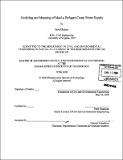| dc.contributor.advisor | Peter Shanahan. | en_US |
| dc.contributor.author | Rahimi, Navid | en_US |
| dc.contributor.other | Massachusetts Institute of Technology. Dept. of Civil and Environmental Engineering. | en_US |
| dc.coverage.spatial | a-th--- | en_US |
| dc.date.accessioned | 2008-12-11T18:44:20Z | |
| dc.date.available | 2008-12-11T18:44:20Z | |
| dc.date.copyright | 2008 | en_US |
| dc.date.issued | 2008 | en_US |
| dc.identifier.uri | http://hdl.handle.net/1721.1/43879 | |
| dc.description | Thesis (M. Eng.)--Massachusetts Institute of Technology, Dept. of Civil and Environmental Engineering, 2008. | en_US |
| dc.description | Includes bibliographical references (p. 94-97). | en_US |
| dc.description.abstract | This thesis describes the development and use of a model, using the EPANET computer code, to simulate the three-hour intermittent MaeLa refugee camp water supply. In coordination with Aide Medicale Internationale, a field survey and pressure, flow and salt tracer testing were conducted as a basis to model the water distribution system in MaeLa, Thailand. The collected data was assembled in EPANET and controls were added to best represent the functioning of the water system and to simulate the calibration tests. The model simulated field parameters successfully despite inaccuracies in elevation due to imprecise instrumentation. The model served as a tool to further understand the dynamics of the system such as mixing in the supply tanks, connections between subsystems and system controls. The distribution model was used to evaluate three alternative scenarios to improve system performance. The objective of the first and second scenario was to increase the flow rate at taps of low supply; the third scenario aimed at adding taps to parts of the camp without easy access to running water. The first scenario consisted in opening valves to connect subsystems: it increased the flow rate at taps of large supply more so than at taps of low supply. This scenario was not recommended because it would quickly drain parts of the water supply. The second scenario consisted in adding connecting pipes between subsystems of high pressure and those of low pressure. It was recommended because it would increase the flow rate of low and medium supply taps. For the third scenario, areas of the camp without easy access to water were defined by using the result of mapping the current system and the population distribution in a Graphical Information System software. | en_US |
| dc.description.abstract | (cont.) These new taps were successful in providing water to these areas without significantly affecting the rest of the system. An additional recommendation for increasing the water supply in the camp was found from analyzing tank level: because tanks would not drain by the end of the distribution period, it was recommended that the period of water supply be increased from 3 hour periods to 4 1/2 hours. Further study is recommended for improving the elevation accuracy of the model, running more calibration studies and running an optimization model for maximizing water supply. | en_US |
| dc.description.statementofresponsibility | by Navid Rahimi. | en_US |
| dc.format.extent | 190 p. | en_US |
| dc.language.iso | eng | en_US |
| dc.publisher | Massachusetts Institute of Technology | en_US |
| dc.rights | M.I.T. theses are protected by
copyright. They may be viewed from this source for any purpose, but
reproduction or distribution in any format is prohibited without written
permission. See provided URL for inquiries about permission. | en_US |
| dc.rights.uri | http://dspace.mit.edu/handle/1721.1/7582 | en_US |
| dc.subject | Civil and Environmental Engineering. | en_US |
| dc.title | Modeling and mapping of MaeLa refugee camp water supply | en_US |
| dc.type | Thesis | en_US |
| dc.description.degree | M.Eng. | en_US |
| dc.contributor.department | Massachusetts Institute of Technology. Department of Civil and Environmental Engineering | |
| dc.identifier.oclc | 263435883 | en_US |
